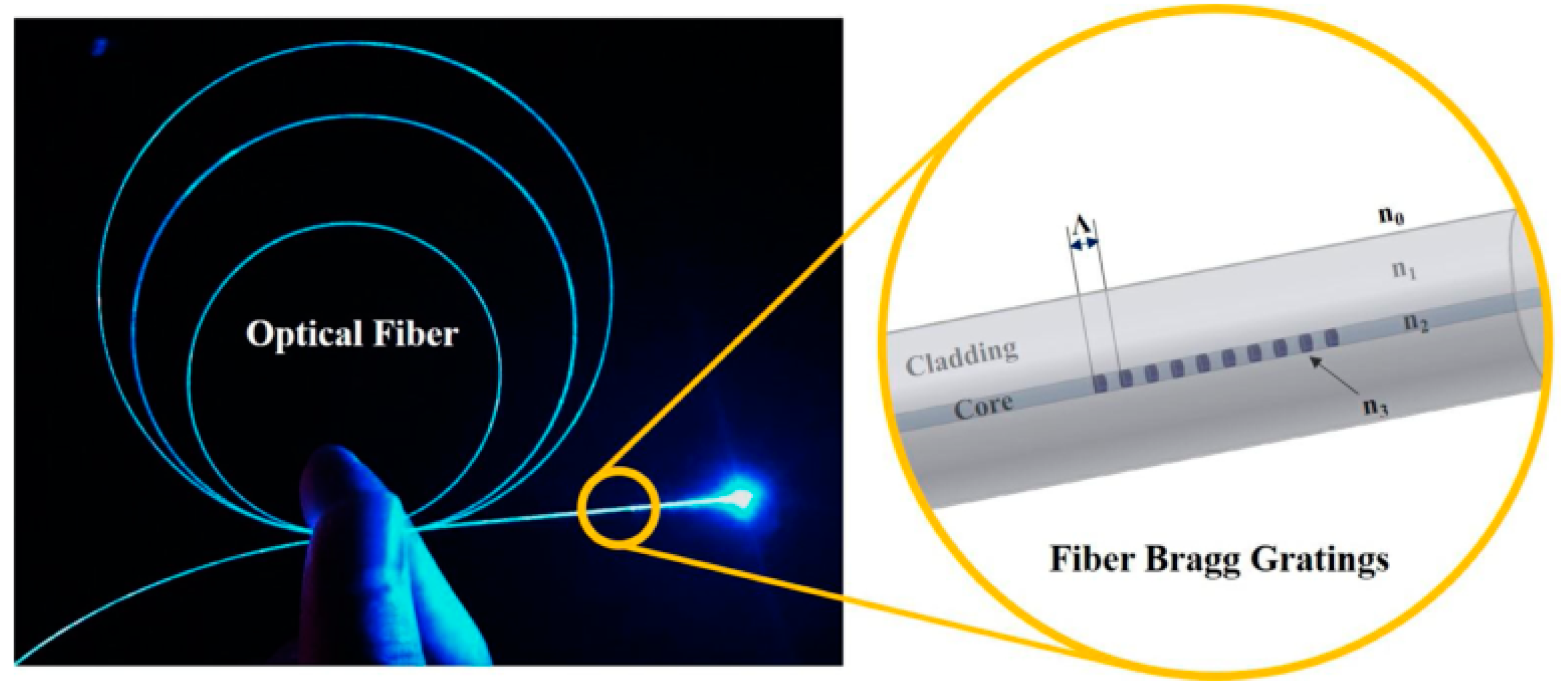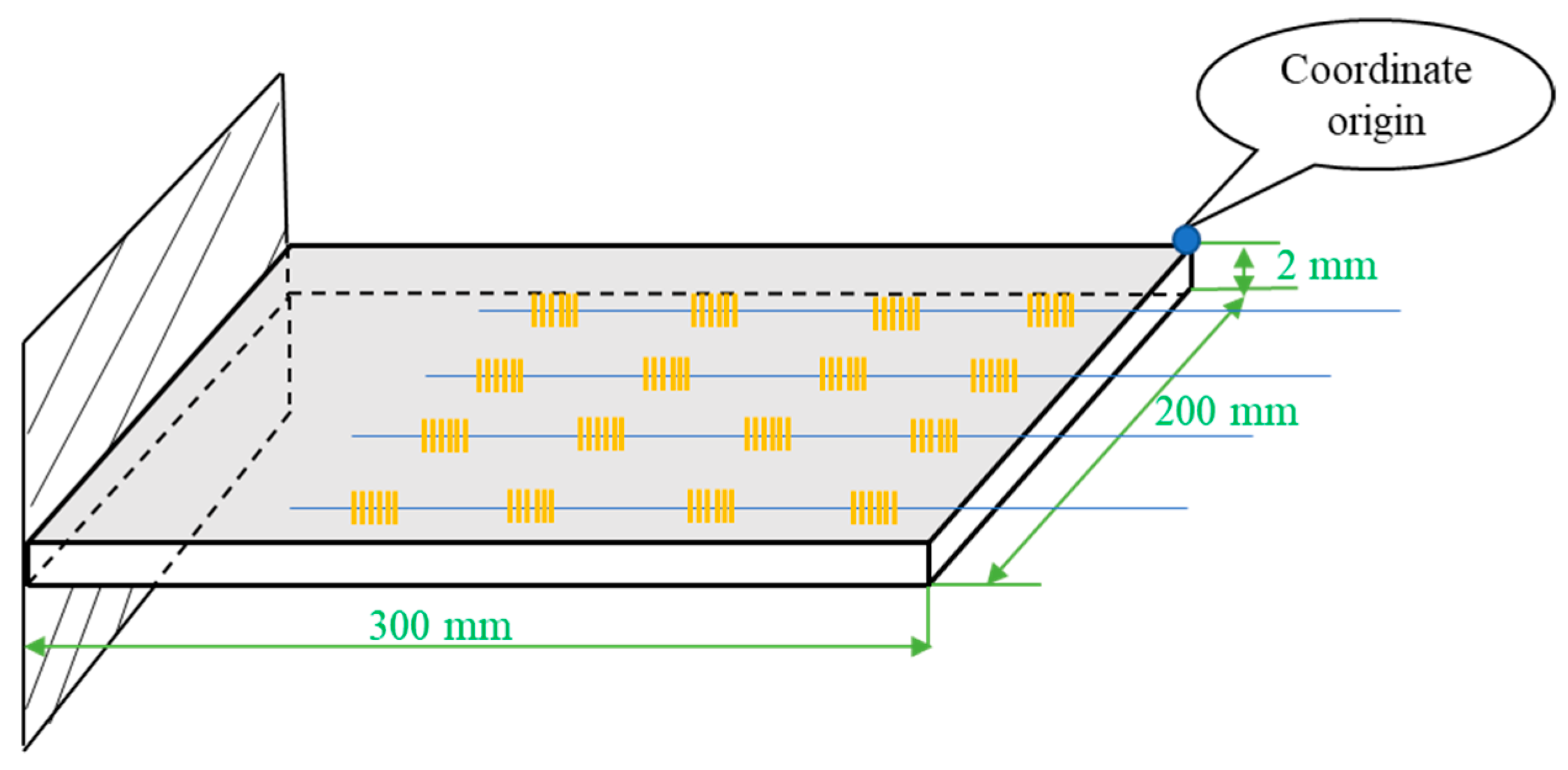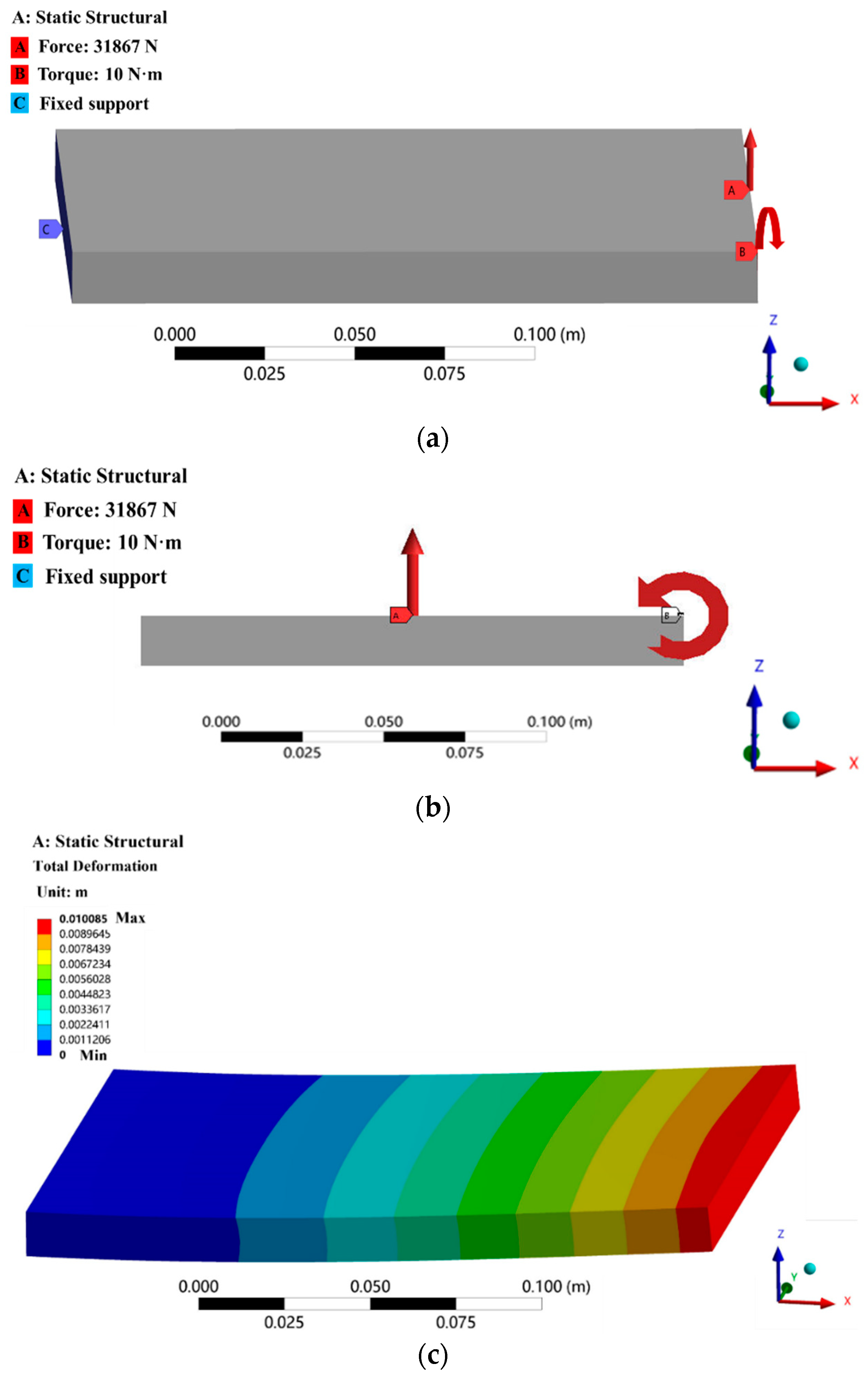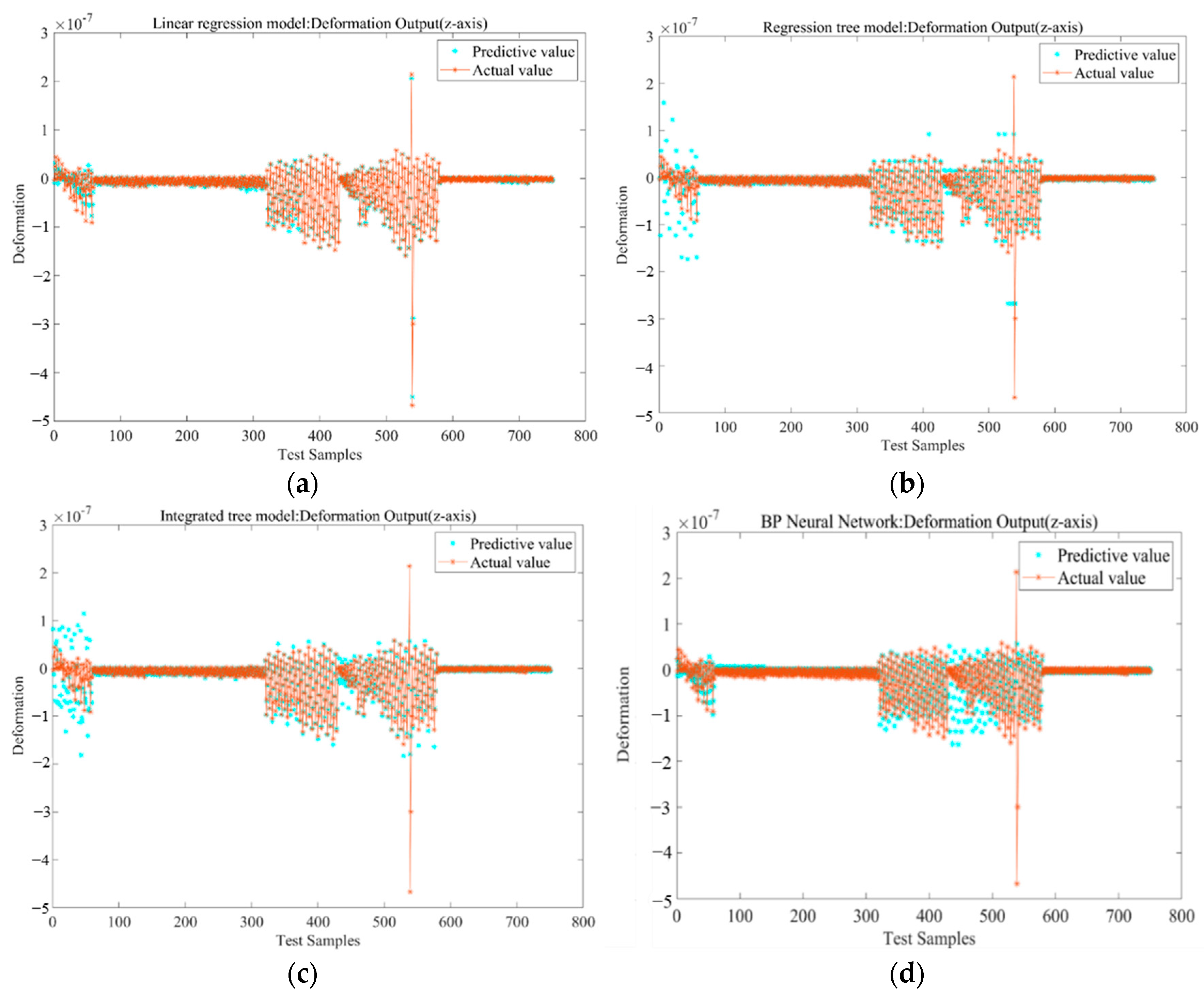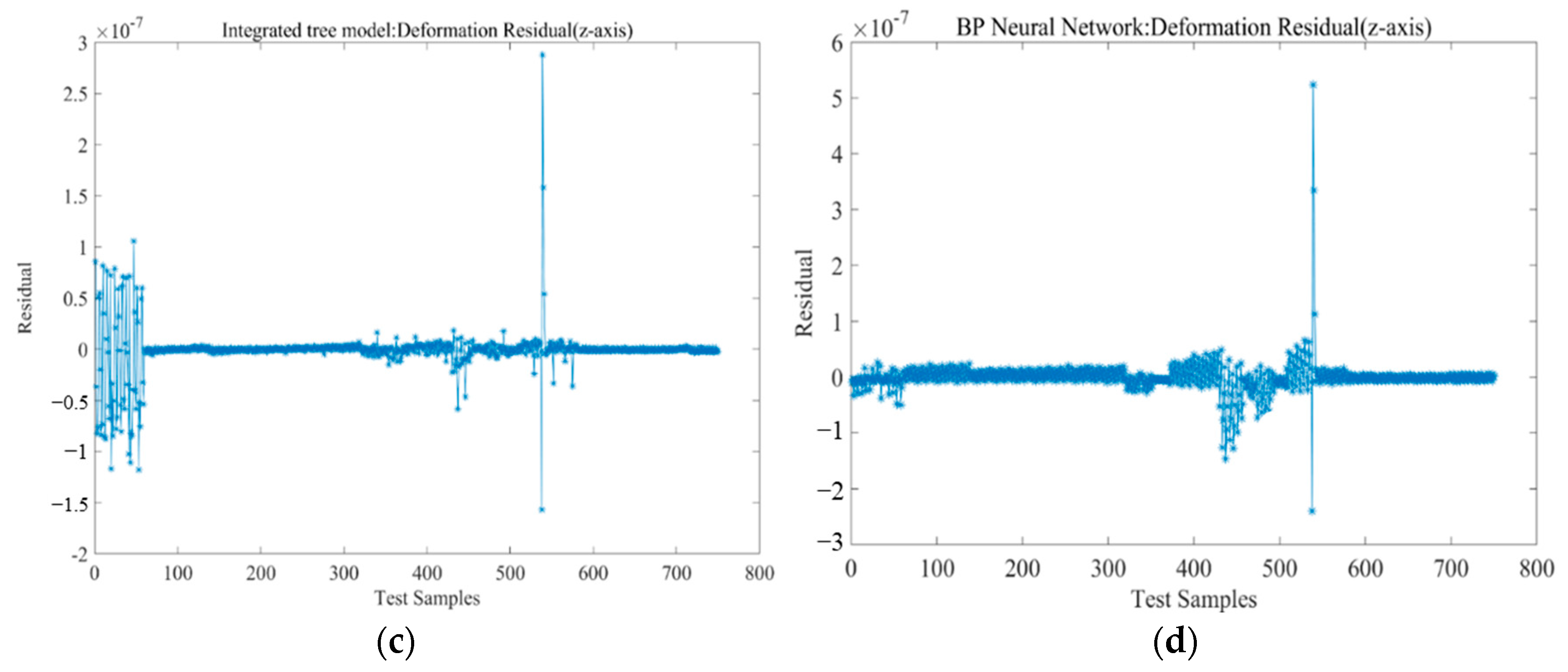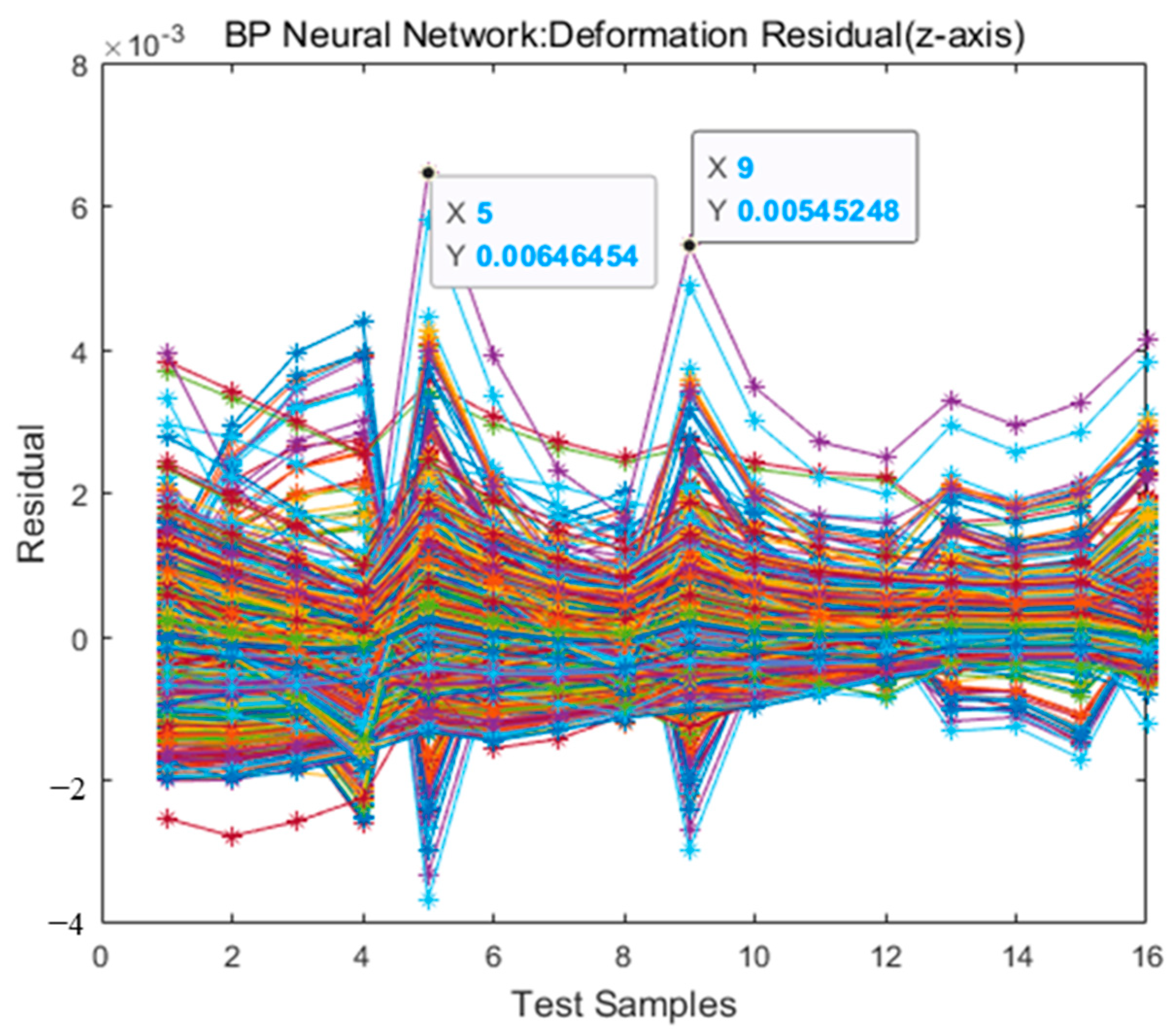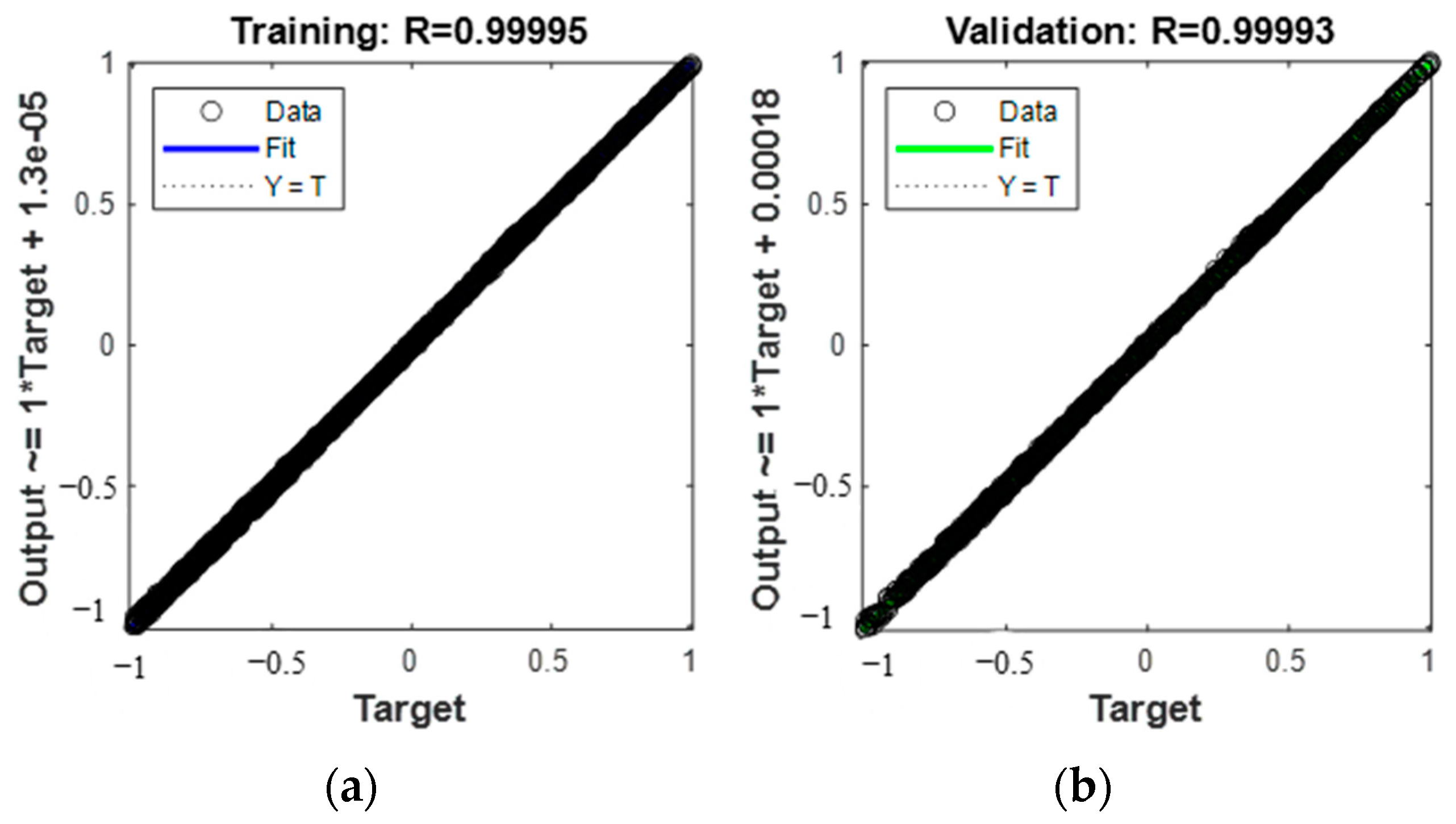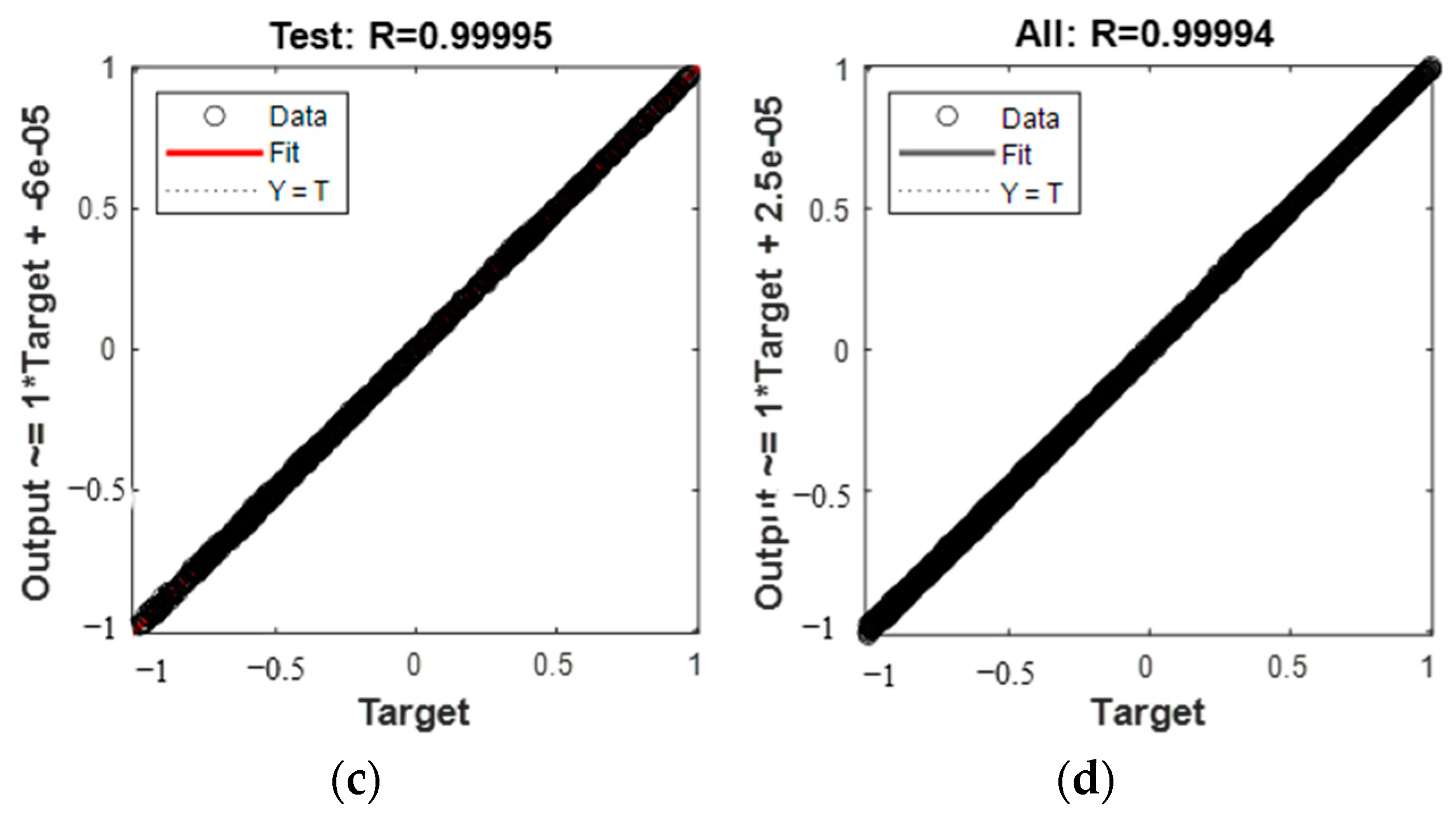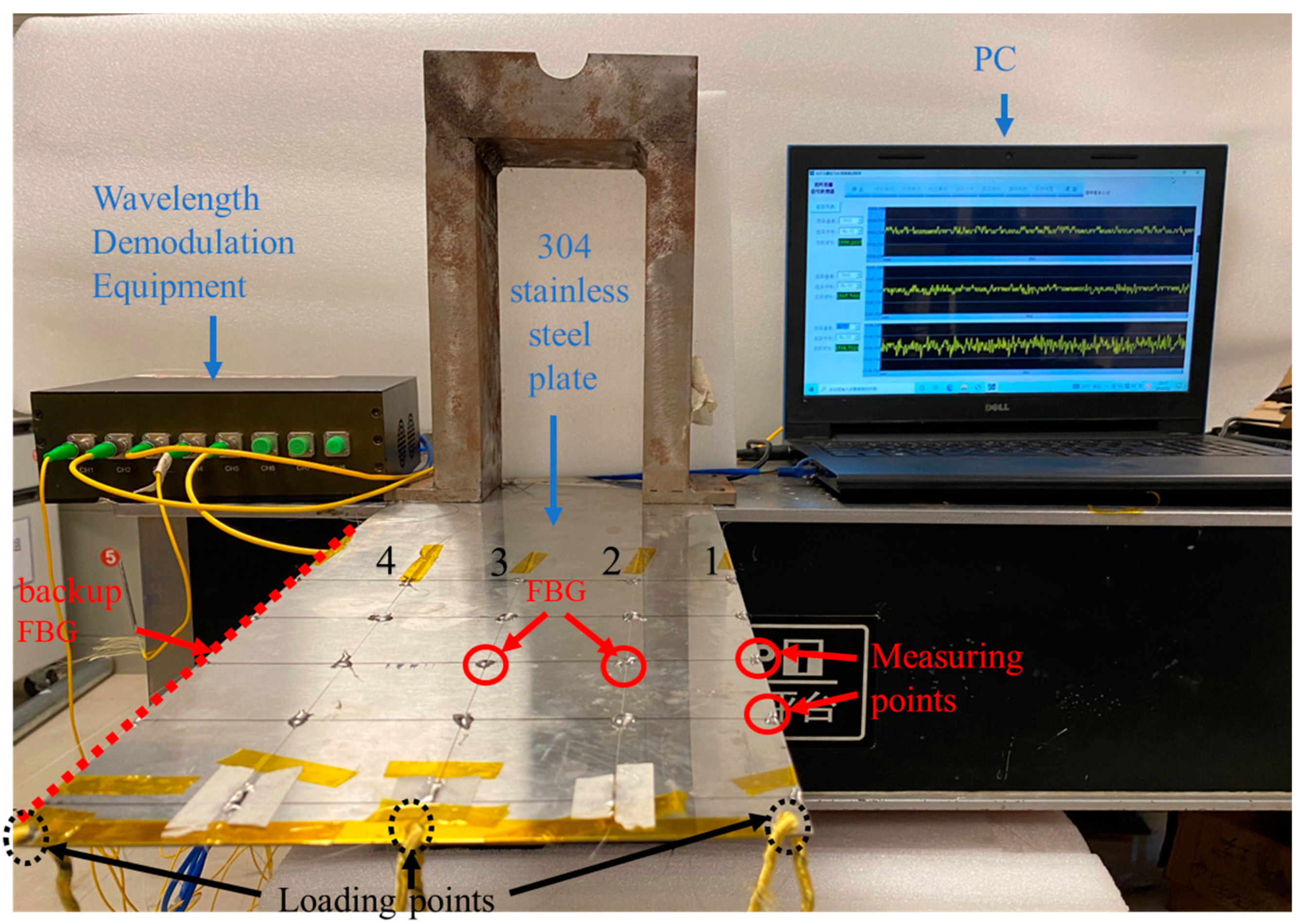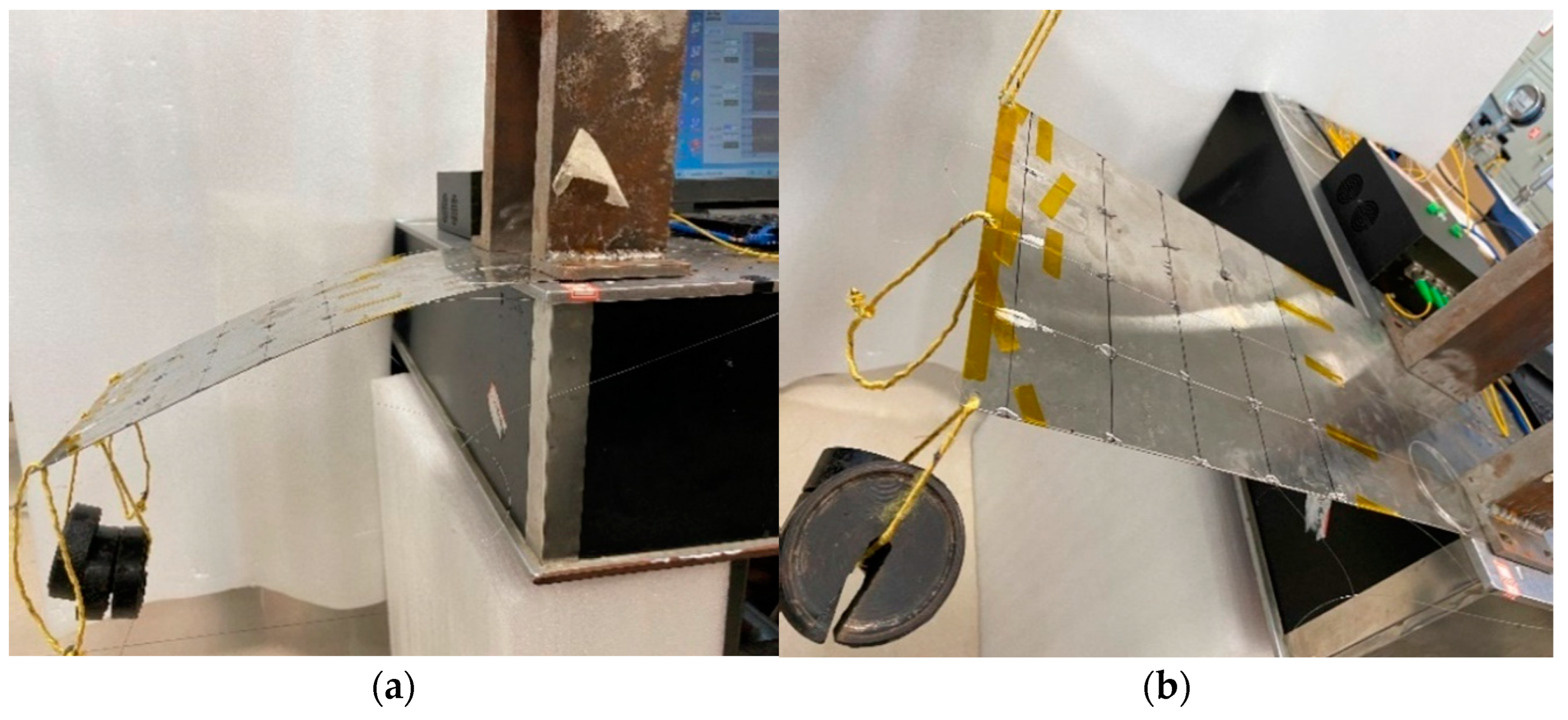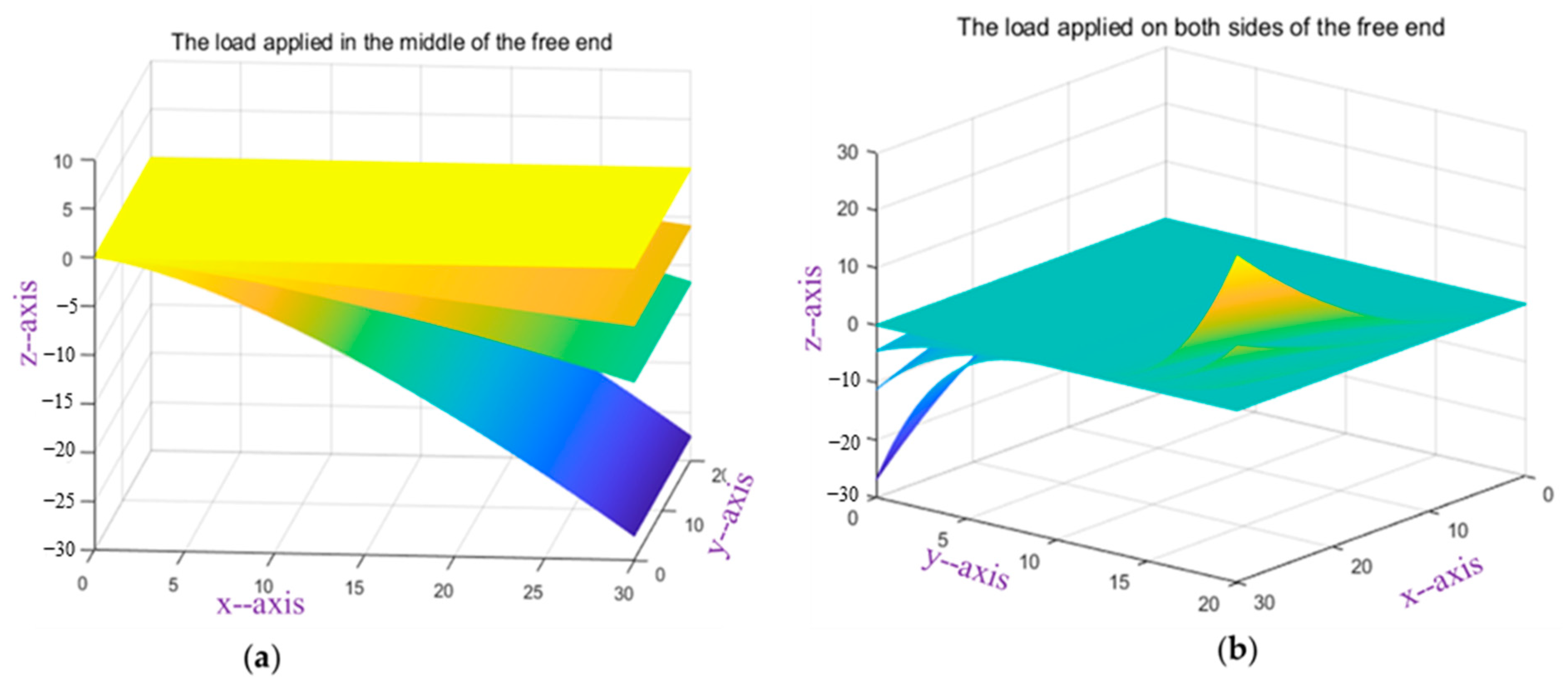1. Introduction
Deformation monitoring and shape reconstruction of large flexible planar structures are one focal point of current research, such as the wind power engine impeller, solar panel, aircraft wing, helicopter blade, and other structural monitoring, which is favored by many scholars. The research method is also becoming increasingly diverse; for example, the inverse finite element method (IFEM) [
1,
2,
3], ko displacement theory [
4,
5], camera measurement method [
6,
7], fiber grating sensing measurement method [
8,
9,
10,
11,
12,
13] (FBG is a popular direction in current sensor research, and its applications are wide [
14,
15]), etc. Each of the above methods has its own characteristics [
16]. The ko displacement theory is based on segmental linearization, which requires a large number of sensors to ensure the accuracy of the measurement. The camera measurement method requires high image clarity, resulting in a large amount of data by system processing and poor real-time monitoring, which is not suitable for real-time monitoring of large flexible planar structures. Relatively, the IFEM and fiber grating sensing measurement method are applied and promoted to a higher degree at present. Dong et al. [
17] proposed an IFEM based on beam elements to reconstruct the shape of the main load-bearing structure of an adaptive deformable wing. Kefal et al. [
18] applied the IFEM to the real-time displacement reconstruction of a wing sandwich structure with medium thickness through a strain sensor network and obtained 3D real-time deformations and strains in agreement with the DIC/FEM results. Wang et al. [
19] proposed a pipeline deformation monitoring method using the IFEM based on iBeam3 units. The experimental results show that the method can effectively monitor the deformation of buried pipelines in the process of soil freezing and thawing with a measurement error of 15.43%. Gherlone et al. [
2] proposed a method based on the IFEM using measured surface strain data to reconstruct the elastic dynamic structural response of trusses, beams, and frame structures. Oboe et al. [
20] proposed an improved IFEM based on isogeometric analysis (IGA), which conducted centralized loads and distributed load tests on the wing structure and obtained more accurate and effective displacement reconstruction. Zhao et al. [
21] proposed an improved IFEM based on IGA to perform concentrated and distributed load tests on the wing structure. The experimental results showed that the improved IFEM was more accurate and effective in displacement reconstruction. However, in the above documents, the choice of mathematical models and boundary conditions of the IFEM did not give a specific derivation process or the selection of standard descriptions, all of which were from personal experience.
FBG is increasingly being used in shape reconstruction. Floris et al. [
22] listed various specific structures of FBG shape sensors to bring significant advances in aerospace engineering and biomedical applications. Wu et al. [
23] proposed an improved object shape reconstruction method based on a FBG shape sensor by embedding FBG arrays into silica gel to reconstruct the object shape. In 2012, Luna [
24] used multicore optical fiber as a shape sensor to reconstruct the spatial shape of the airfoil surface with a reconstruction error of 1.5% or less. Wu et al. [
25] designed a high-precision soft substrate shape sensor based on a dual fiber grating, which was able to improve the shape reconstruction accuracy with a reconstruction error of 6.13%. He et al. [
26,
27] designed two different types of curvature sensors using silicone and polyimide with FBG to complete the 3D shape reconstruction of the airfoil. Wang et al. [
28] proposed a curvature sensor based on a polyimide sensing layer to achieve bending shape monitoring of soft surgical manipulators, and the experimental results showed that the maximum error between the measured value and the actual bending curvature was less than 2.1%. Fiber grating sensing measurement methods can achieve real-time measurements of flexible planar structures based on diverse fiber grating sensing forms [
29,
30,
31,
32], but there is a strong dependence on the specific structure curvature (shape) sensor, while the curvature (shape) sensor preparation error and calibration error also have an impact on the measurement accuracy of the system.
The rapid development of artificial intelligence techniques has promoted the combination of structural deformation monitoring with machine learning, such as neural networks [
33,
34,
35], decision trees, support vector machines, linear regression, and random forests. The above algorithms are used in conjunction with FBG to predict the displacement or load of flexible planar structures to improve the measurement accuracy with the help of big data-driven models. Kim et al. [
36] used multiple linear regression and variance analysis to optimize the design of rotor shapes. Kaveh et al. [
37] used different machine learning techniques to establish the relationship between the fiber angle and the flexural capacity of a cylinder under bending-induced loads to predict the final buckling load of the variable stiffness composite cylinder. Sefati et al. [
38,
39] investigated three data-driven models for tip position estimation (DPE) of surgical manipulators and compared DPE and shape reconstruction results, with the following maximum absolute errors observed for DPE: 0.78 mm and 2.45 mm for free bending motion and 1.22 mm and 3.19 mm obstacles for task space, indicating that, compared to conventional methods, the proposed data-driven method has superior performance. Lum et al. [
40] studied robots using FBG to provide position information and machine learning to build models for real-time, robust, and reliable shape reconstruction. Alexakis et al. [
41] provided a new approach to apply statistical modeling and machine learning to install a FBG network on a Victorian railroad viaduct to track train speeds and dynamic strain amplitudes of the bridge. Klotz et al. [
42] developed a generalized deflection and twist measurement method for wings based on FBG and neural networks to achieve real-time wing deformation measurements on the ground and in the air. Li et al. [
43] developed a model-free method based on neural networks to reconstruct the shape of a continuous robotic arm. The experimental results showed that the reconstruction accuracy was improved compared with the traditional method.
There is much reference on the application of FBG combined with machine learning, but not much reference on the combination of deformation monitoring of large flexible planar structures with machine learning. In response to the problems of low accuracy, a large number of sensors, and serious dependence on specific structural curvature (shape) sensors or personal experience, this paper proposes a method of flexible structural deformation measurement based on FBG and machine learning to reconstruct flexible structural shapes in real time. Different from most reconstruction methods of flexible planar structures based on FBG curvature (shape) sensors, the proposed method is based on deformation variables of measuring points on the flexible structure surface to complete the shape reconstruction of the structure. To achieve the method, four FBG grating arrays are set on the surface of the flexible structure to obtain the strain values of measuring points on the structure surface from the FBG grating. Using machine learning, the model of the strain value and the deformation variables of measuring points are trained and established. The deformation variables (in the x-axis, y-axis, z-axis direction) of each measuring point on the structure surface are predicted to obtain the real-time three-dimensional coordinate value of each measuring point. Finally, by an improved Kalman filter algorithm, the 3D shape of the flexible structure deformed by bending and twisting is reconstructed.
We theoretically change the traditional working model of flexible planar structure deformation monitoring, verify the linear relationship between the strain and deformation of the measuring points and collect a large number of training data samples by using ANSYS finite element software, introduce the data-driven concept, and establish the mapping relationship between the strain and deformation of measuring points through machine learning methods, which increases the dependence of the monitoring system on the training data, reduces the dependence of flexible structural deformation monitoring on specific structural curvature (shape) sensors, and reduces the influence of empirical factors such as mathematical formulas and boundary conditions on shape reconstruction. By replicating the contents of the simulation tests on small flexible plate specimens, we verified the feasibility of the proposed method and the accuracy of the predicted values of the machine learning model with predictive error values that match the existing test environment.
Therefore, the main contributions of this paper are as follows.
- (1)
Breaking through traditional mode-driven thinking, the development of a design framework for monitoring the deformation of flexible planar structures based on the combination of FBG arrays and the machine learning algorithm. The 4 × 4 FBG grating arrays are used to monitor the strain values of measuring points of flexible planar structures in real time. The machine learning algorithm predicts the deformation variables of each measuring point.
- (2)
A system simulation model is established by ANSYS finite element software to provide a large amount of training data for machine learning, and the mapping relationship between the strain and deformation variables of each measuring point on a flexible flat structure is established.
- (3)
Machine learning algorithms such as the multiple linear regression model, regression tree model, integrated tree (bagging tree) model, and BP neural network are listed and compared for the prediction of the deformation variables of measuring points; the BP neural network obtains higher accuracy for structural shape reconstruction due to the coefficient of determination R2 of 0.9091/0.9979/0.9964.
- (4)
The introduction of the data-driven model increases the dependence of the monitoring system on the obtained training dataset and replicates experiments to demonstrate the feasibility and reliability of the proposed method, which achieves more stable and reliable shape reconstruction without either customizing the FBG curvature (shape) sensors for various structures or relying on an empirical selection of functional relationships compared to the references [
26,
27].
4. Experiments and Results
To verify the proposed method of flexible planar structure deformation monitoring and shape reconstruction, the experimental platform shown in the simulation system was replicated as shown in
Figure 9.
As shown in
Figure 9, the test consists of a computer, an eight-channel FBG high-speed wavelength demodulator, FBG grating sensing network, and flexible structural specimen. The structural specimen is made of 304 stainless-steel with the same size as the ANSYS finite element simulation software, in which one end is fixed, and three holes are drilled in the other free end. The three holes are the “Loading points”, which used to hang mass blocks of different weights to simulate different loading states. The “Measuring points” are randomly selected FBG grating sensing network to compare the predicted values with the actual values, The FBG grating sensing network is composed of four FBG grating arrays. Each grating array connects four FBG sensors in series, and one FBG sensor represents a measuring point. The grating array is produced by Zhongshan Jingliang Optoelectronics Technology Co., Ltd(Zhongshan City, China). Taking the third grating array in
Figure 9 as an example, the FBG sensor parameters are shown in
Table 6 below.
The experimental content is carried out in two conditions. One is gradually to load the mass blocks, which are 250 g, 500 g, 1500 g, at the loading point in the middle of the free end of the structural specimen, which makes the structural specimen bend and deform, as shown in
Figure 10a. The improved Kalman filter algorithm is used to reconstruct the 3D shape of the structural specimen in MATLAB software, as shown in
Figure 11a. The other is to load different loads at the loading points on both sides of the free point of the structural specimen. One loading point is suspended with a mass block, and the other loading point is pulled up, which continuously loads three states, as shown in
Figure 10b. The three-dimensional shape reconstruction of the structural specimen is shown in
Figure 11b.
Any two points on the structural specimen are selected to compare the coordinate values obtained by different measuring methods in different states to evaluate the model prediction accuracy. The measuring points are shown as green circles in
Figure 9.
Due to the limited experimental environment and equipment, the true value is measured by micrometers, and the
y-axis coordinate values do not change when the flexible planar structure is bent and deformed during loading of the middle loading point. The value of the
x-axis,
y-axis, and
z-axis coordinate changes when the flexible planar structure is deformed by the torque.
Table 7 and
Table 8 show that the larger the deformation variables of the measuring point are, the higher the accuracy of the predictive result. The maximum predictive error of the
x-axis coordinate value is 2.93%; the maximum predictive error of the
y-axis coordinate value is 35.59%; and the maximum predictive error of the
z-axis coordinate value is 16.21%, so the predictive accuracy is relatively high, especially the prediction of the
x-axis coordinate value. The predicted results are highly consistent with the expected results under the existing test environment and equipment.
5. Discussion
We propose a method for measuring the deformation of flexible planar structures based on FBG and machine learning and verify the feasibility and reliability of the method from both theoretical and experimental aspects in this paper.
In the model simulation,
Figure 2,
Figure 3 and
Figure 4 show that there are linear relationships between each point strain value and variables on the flexible planar structure. Additionally,
Table 3,
Table 4 and
Table 5 show that, in the case of known strain variables of the measuring points, the comprehensive coefficient of determination R
2 = 92.29% reflects that the predictive accuracy of the BP neural network model outperforms that of the multivariate linear fit model, regression tree model, and integrated tree model.
In the replication experiment, Table 7 and
Table 8 show that the maximum error of the predicted coordinate value of the measuring points,
x-axis <
z-axis <
y-axis, especially the deformation variables in the
z-direction of the measuring points, are the maximum, and the maximum error of the predicted coordinate value in the
z-axis direction is 16.21%. The flexible planar structure will be slightly deformed in the
y-axis direction due to the torque, and the predicted error of the coordinate value will be increased because the deformation variable is too small. The minimum predicted error in the
y-axis direction is 8.22%, but, overall, all the errors are within an acceptable range. In the references [
27,
46], the authors’ team pasted 48 FBGs onto a polyimide film to form a flexible wing smart skin, calculated the bending curvature of the polyimide skin, and reconstructed the 3D shape of the polyimide skin with different wing profiles. Compared with the 3D vision, the maximum error in the
z-axis was less than 5%. However, only one state of bending deformation is considered in the reference, and the 3D reconstruction of the action of the torque was not described. The maximum predicted error in the
z-axis under bending deformation is 4.93% in this paper. In the reference [
17], the authors used the IFEM based on beam elements to reconstruct the main load-bearing structure of a deformable wing with a fishbone shape, and the deformation of the fishbone structure was mainly displacement along the
z-axis. The total error of all strain measuring points on the fishbone structure did not exceed ±3 mm; the error at the tip was 3 mm; and the global maximum displacement reconstruction error was less than 8.62%. This reference was based on the free tetrahedral mesh of COMSOL for finite element simulation analysis of the fishbone structure of the adaptive deformable wing. The simplification of the model, the derivation of the formula, and the selection of the boundary conditions were not given a specific derivation process but came more from experience.
In a comprehensive comparison, the reconfiguration method proposed in this paper is based on data-driven thinking modes to establish a training framework of the flexible structural measuring point strain—deformation variables based on FBG and machine learning—to obtain measuring point deformation variables from measuring point strain characteristic information, which can dilute the dependence of the monitoring system on empirical and mathematical models and reduce the dependence of the system on specific structural curvature sensors. The advantages of the reconstruction method proposed in this paper are as follows.
(1). The proposed method can not only solve the shape reconstruction of flexible planar structures due to bending deformation but also the shape reconstruction of the deformation generated by torque. At present, most studies regarding the reference of flexible structural deformation only consider the shape reconstruction of bending deformation, such as in reference [
46,
47], so the method proposed in this paper improves the accuracy of shape reconstruction from the type of deformation.
(2). The introduction of the data-driven model breaks through the traditional shape reconstruction thought process. The traditional flexible planar structure shape reconstruction is mostly used with mode-driven thought processes, whether it is based on curvature shape reconstruction or inverse finite element reconstruction methods, all of which are secondary developments based on the experience or functional relationships accumulated in the early stage. For example, the reference [
25] used shape reconstruction based on FBG curvature sensors by first determining the curvature in FBG curvature sensors as a function of the wavelength drift of the center of the FBG and then considered the reconstruction relationship between curvature and shape later.
(3). Finally, the BP neural network training model is selected to establish the prediction model of the strain and deformation of the measuring points, and the prediction accuracy of the model has a large impact on the accuracy of shape reconstruction. When the BP neural network uses the sigmoid function as the activation function, any function can approach a three-layer network with arbitrary accuracy. The BP neural network model trained in this paper maintains low deviation and variance, as shown in
Figure 6, and has good predictive performance.
However, in the replication experiment, the predictive errors in the three axes caused by the torque are quite different. In particular, the maximum predictive error on the y-axis is 35.59%. There are two main reasons for this.
(1). Due to limited experimental conditions, the error caused by the tools and methods of measurement has a greater impact, especially the deformation in the y-axis, which is small, and the error brought by the measurement is larger. In the follow-up, a 3D high-definition camera or total station should be used as the actual value measurement tool.
(2). In the training samples, the y-axis deformation is small, and the true value of the output is small, such as loading a 360 N vertical downward force at the loading point on the left side of the flexible planar structure. The deformation variable of measuring point 1 in the y-axis is 6.78 × 10−7 m. The predictive accuracy will be amplified in the process of performing the conversion of the measuring point coordinate values. In the follow-up training model, for the case where there are small values of data in the training samples, it is considered to use a comprehensive training model to improve the prediction accuracy.
